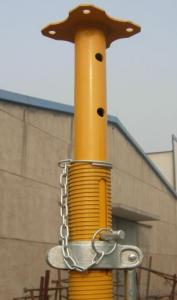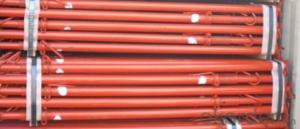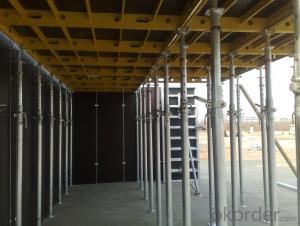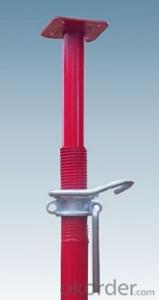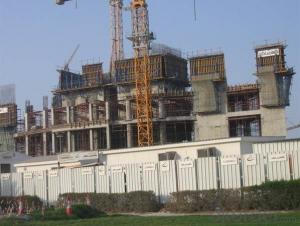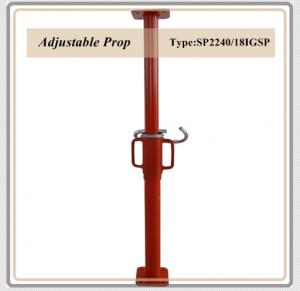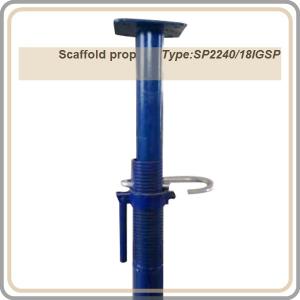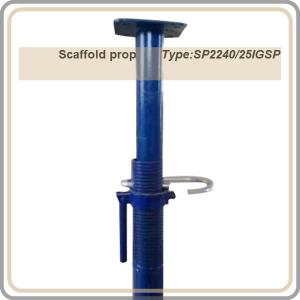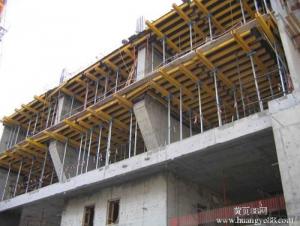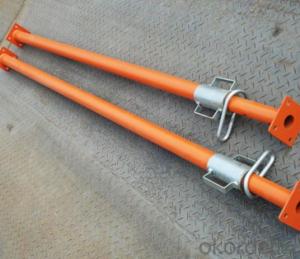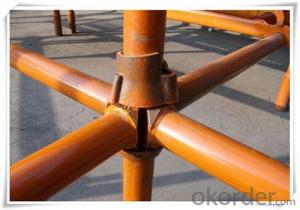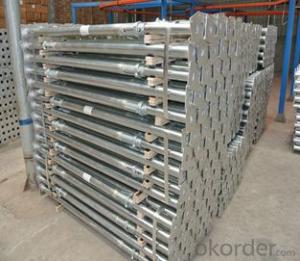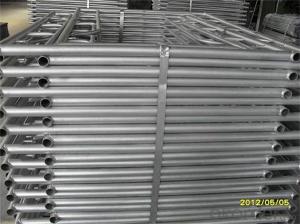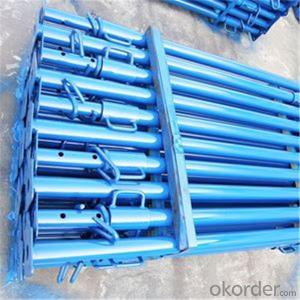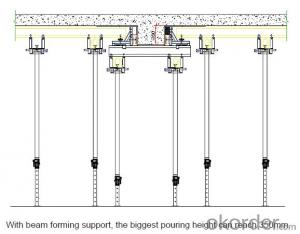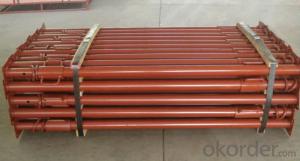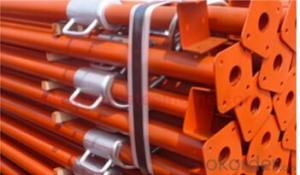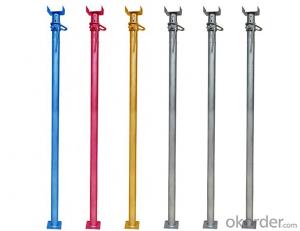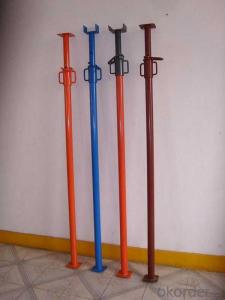Q235 material Painted Italian Type Scaffolding steel Prop
- Loading Port:
- China Main Port
- Payment Terms:
- TT OR LC
- Min Order Qty:
- -
- Supply Capability:
- -
OKorder Service Pledge
OKorder Financial Service
You Might Also Like
Quick Details
| Type: | |||||
| Scaffolding Part Type: | Scaffolding steel Prop: | material: | |||
| Inner Tube: | outer tube: | plate: | |||
| Weight: | Finish: | Delivery: | |||
| Price: |
Packaging & Delivery
| Packaging Detail: | n Pallets Or Customer Needs |
| Delivery Detail: | 30days |
Specifications
Q235 material Painted Italian Type Scaffolding steel Prop
1.Finish: Painted, Powder Coated,
Zinc Plate, Hot Dip Galvanized
Q235 material Painted Italian Type Scaffolding steel Prop
1.Material: Q235
2.Type: light type, heavy duty type
3. Sizes: according to customer's requirement
4.surface treatment: painted, powder coated, zinc plated, hot dip galvanized
5.Main market: Middle east, europe, north America, south America
6.Advantage: high quality, reasonable price, delivery in time, good package, and exellent services.
Specifications:
| Description | Length (m) | Outer Tube | Inner Tube | Weight (kgs) |
| Italian Type | 1.60-2.90 | 56 x 1.6m | 48.3 x 1.8m | 9.30 |
| 2.00-3.60 | 56 x 1.6m | 48.3 x 1.8m | 10.00 | |
| 2.20-4.00 | 56 x 1.6m | 48.3 x 1.8m | 11.00 |
- Q: Can steel props be used in dam construction?
- Yes, steel props can be used in dam construction. Steel props provide strong support and stability during the construction process, ensuring the safety and structural integrity of the dam.
- Q: Can steel props be used in residential foundation repair?
- Yes, steel props can be used in residential foundation repair. Steel props, also known as adjustable steel columns or steel shores, are commonly used in construction and foundation repair projects. These props are designed to provide temporary support to damaged or weakened structures, including residential foundations. Steel props offer several advantages in foundation repair. Firstly, they are adjustable, allowing for precise leveling and support of the foundation. This adjustability ensures that the props can accommodate the specific needs of the foundation, providing optimal support. Additionally, steel props are highly durable and can withstand heavy loads, making them suitable for residential foundation repair. Moreover, steel props are versatile and can be used in various foundation repair techniques. For instance, they can be utilized in underpinning, a method that involves strengthening and stabilizing an existing foundation. Steel props are also commonly used in foundation jacking, which involves lifting and re-leveling a sinking or settling foundation. However, it is essential to consult with a professional engineer or foundation repair specialist before using steel props in residential foundation repair. These experts can assess the specific conditions of the foundation and determine the most suitable repair methods and materials. Overall, steel props are a reliable and effective solution for residential foundation repair. They offer adjustable support, durability, and versatility, making them a popular choice in the construction industry.
- Q: What are the common load distribution methods for steel props?
- The construction industry widely employs various load distribution methods for steel props. Timber or steel needles, in combination with steel props, are one of the most commonly used approaches. This entails placing horizontal beams (needles) on top of multiple props to evenly distribute the load. To ensure stability and prevent bending or sagging, the needles are typically supported by steel or timber supports at regular intervals. Another prevalent method involves using steel spreader plates. These flat, steel plates are positioned on the prop's base plate to evenly distribute the load over a larger surface area. This reduces the risk of localized pressure points and guarantees stability. Adjustable steel frames or frames with multiple props are sometimes utilized as well. These frames consist of interconnected props with horizontal beams or braces, creating a robust structure capable of handling heavier loads. By distributing the load among multiple props, these frames promote weight distribution and enhance stability. Furthermore, load-bearing beams or lintels can be employed to distribute the load from above. Supported by steel props, these beams transfer the load to the props, thereby distributing the weight across multiple points. It is important to note that the most suitable load distribution method for steel props in a specific construction scenario depends on various factors, including the weight and size of the load, the span between the props, and the desired level of stability. Consulting with a structural engineer or an experienced professional is advisable to determine the appropriate load distribution method.
- Q: How is a steel prop different from other types of supports?
- A steel prop is different from other types of supports primarily because it is made of durable and sturdy steel material, which provides excellent strength and stability. Unlike wooden or plastic supports, a steel prop can withstand heavy loads and is resistant to wear and tear. Additionally, steel props are adjustable, allowing for easy height modifications to suit different construction needs.
- Q: Are steel props adjustable in both horizontal and lateral directions?
- No, steel props are typically adjustable in only the vertical direction.
- Q: Can steel props be used in extreme weather conditions?
- Yes, steel props can be used in extreme weather conditions. Steel is a durable and strong material that can withstand harsh weather elements such as high winds, heavy rain, and extreme temperatures. However, it is important to ensure proper maintenance and inspection of the steel props to ensure their structural integrity and safety during such conditions.
- Q: How do steel props compare to jack posts in terms of performance?
- Steel props and jack posts are both commonly used for providing temporary support during construction or renovation projects. However, in terms of performance, steel props are generally considered to be more robust and versatile than jack posts. Steel props are adjustable and can be easily extended or shortened to fit various heights and support requirements. They are made of high-quality steel, which makes them durable, strong, and capable of bearing heavy loads. Steel props also offer a greater range of load-bearing capacity compared to jack posts. On the other hand, jack posts, also known as screw jacks or adjustable steel columns, are typically used for lighter loads and have a limited height adjustment range. While they are suitable for certain applications, such as residential projects or minor support needs, they may not provide the same level of stability and load-bearing capacity as steel props. Overall, steel props are generally preferred when it comes to performance due to their adjustable nature, higher load-bearing capacity, and durability. However, the choice between steel props and jack posts ultimately depends on the specific requirements and load conditions of the project at hand.
- Q: Can steel props be used in supporting heavy machinery during installation?
- Steel props are a viable option for supporting heavy machinery during installation. These props, also known as adjustable steel props or steel shoring props, are commonly utilized in the construction and engineering industries to provide temporary support and stability. They are specifically designed to endure heavy loads and can be adjusted to the desired height. To prevent accidents or damage when installing heavy machinery, it is imperative to ensure proper support. Steel props offer a dependable solution as they are constructed from high-quality steel, ensuring strength and durability. They can withstand significant weight and distribute it evenly, creating a stable foundation for the machinery. Furthermore, steel props are capable of being adjusted, enabling precise height alterations according to the machinery's requirements. This adjustability facilitates the alignment of the machinery and ensures a proper installation. Nevertheless, it is crucial to consider the machinery's specific requirements and specifications before employing steel props. Thorough assessment of the machinery's weight, dimensions, and center of gravity is essential in order to determine the necessary number and placement of the props. It is also recommended to consult with a structural engineer or an expert in heavy machinery installation to guarantee the safety and effectiveness of using steel props in this particular application. In conclusion, steel props possess the necessary qualities of strength, adjustability, and stability to serve as a suitable choice for supporting heavy machinery during installation.
- Q: How do you ensure proper leveling of steel props?
- To ensure proper leveling of steel props, there are a few key steps that need to be followed. Firstly, it is important to check the ground conditions where the props will be placed. The ground should be firm and even, without any loose soil or debris. If necessary, the ground can be compacted or leveled using a compactor or a levelling tool. Next, the steel props themselves should be inspected for any damage or defects. It is crucial to use props that are in good condition and suitable for the intended load. The props should also be of the correct height for the specific application. When placing the props, it is essential to use a spirit level to ensure they are perfectly vertical. This can be done by adjusting the height of the prop using the prop adjustment mechanism. The spirit level should be placed on top of the prop and checked from all sides to ensure accuracy. Additionally, it is recommended to use a prop plate or a solid base under the prop to distribute the load evenly and prevent any sinking or tilting. The prop plate should be placed on a stable surface, such as a concrete slab or a steel plate. Once the props are in place, they should be periodically checked and adjusted if necessary. This is particularly important if there are any changes in load or ground conditions that could affect the leveling of the props. In summary, ensuring proper leveling of steel props involves checking the ground conditions, inspecting the props, using a spirit level for vertical alignment, using a prop plate for stability, and regularly monitoring and adjusting the props as needed. By following these steps, a safe and stable support system can be established.
- Q: Are steel props adjustable in tight spaces?
- Steel props, widely known as adjustable steel props or steel shores, can be conveniently adjusted in compact areas. These props, frequently employed in construction projects, serve as temporary supports for structures like formwork, scaffolding, or beams. Their composition includes a steel tube with an externally threaded section and an inner tube that smoothly slides within the outer tube. This ingenious design enables effortless alteration of height levels while guaranteeing stability and the ability to bear heavy loads. In confined spaces where mobility may be restricted, the adaptability of steel props permits accurate placement and reliable support, rendering them ideal for a multitude of construction situations.
Send your message to us
Q235 material Painted Italian Type Scaffolding steel Prop
- Loading Port:
- China Main Port
- Payment Terms:
- TT OR LC
- Min Order Qty:
- -
- Supply Capability:
- -
OKorder Service Pledge
OKorder Financial Service
Similar products
Hot products
Hot Searches
Related keywords
